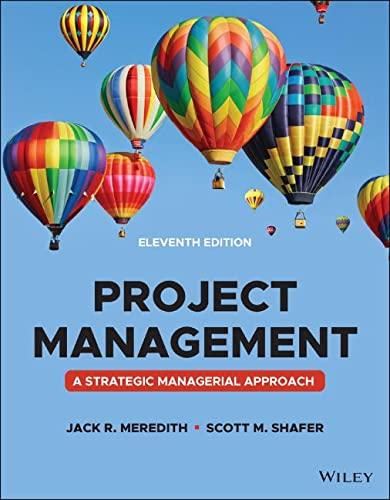Question
I found a recent incident related to water contamination concerns in Philadelphia, which may serve as a case study for analyzing using the Tools of
I found a recent incident related to water contamination concerns in Philadelphia, which may serve as a case study for analyzing using the Tools of Total Quality Management (TQM) and other analytical frameworks.
Incident Overview
The incident in Philadelphia involved a significant scare related to potential water contamination stemming from a chemical spill in Bucks County. An estimated 8,100 gallons of hazardous materials spilled into a tributary of the Delaware River, which posed a potential threat to the city's water supply drawn from the river. The concern was significant enough to prompt city officials to conduct repeated water quality tests and issue public advisories regarding the use of tap water.
Despite the assurance that the water was safe, the incident revealed underlying issues of trust and confidence in the city's water quality. Historical and systemic factors contribute to varying levels of trust in tap water quality among different demographics within the city, with some residents expressing longstanding concerns about the taste, smell, and safety of the water coming from their taps. These concerns reflect a broader national pattern, where trust in public water systems varies significantly across different communities, often influenced by factors such as race, ethnicity, income, and past incidents of water contamination in other locations.
The city's efforts to rebuild trust and ensure the safety of its tap water include public engagement campaigns, initiatives to test for lead, and programs to replace lead service lines. Despite these efforts, incidents like the chemical spill in Bucks County serve as reminders of the challenges faced by public water systems in maintaining safety, managing perceptions of risk, and building public trust in water quality.
Analysis using TQM Tools and Other Analytical Frameworks
a. Source of Defect or Contamination: External Risk Management
The contamination incident, caused by equipment failure at a Bucks County facility, underscores the critical role of external risk management in quality control systems. The incident highlights a need for Supply Chain Management (SCM) strategies that incorporate robust risk assessments and mitigation plans for suppliers and partners, especially those handling hazardous materials. Utilizing the Supplier Quality Management (SQM) process can help in evaluating and ensuring that suppliers meet the required quality and safety standards, potentially preventing such incidents.
b. Isolating the Cause and Potential for Reoccurrence: Cause-and-Effect Diagrams
Employing Cause-and-Effect Diagrams or fishbone diagrams, can facilitate a thorough analysis of potential factors leading to such incidents. This analytical tool helps in categorizing possible causes, such as equipment failure, human error, materials used, and external factors like environmental conditions. Regular inspections and maintenance, highlighted by the incident, are critical, but a broader approach also includes analyzing and enhancing design and operational processes to minimize risks. Implementing a robust Environmental Management System (EMS) within the ISO 14001 framework can help manage environmental risks more effectively.
. Mitigating the Impact and Reassuring the Public: PDCA Cycles
The Plan-Do-Check-Act (PDCA) cycle is pivotal for continuous improvement, especially in crisis situations like this. Applying PDCA to water safety protocols can facilitate:
- Plan: Developing comprehensive emergency response plans and communication strategies.
- Do: Implementing these plans, including regular water testing and infrastructure inspections.
- Check: Monitoring outcomes to assess the effectiveness of these measures and public communication.
- Act: Making necessary adjustments based on feedback and new information.
This incident highlights the paramount importance of communication in managing public safety crises. Ensuring transparent, timely, and effective communication can help maintain or rebuild public trust. Engaging in proactive public education about water safety, the measures in place to protect it, and how residents can respond to potential future incidents is crucial. Additionally, utilizing social media analytics tools to gauge public sentiment and concerns in real time can inform more targeted communication efforts.
Conclusion
The Philadelphia water contamination scare, though resolved without actual harm, serves as a critical learning opportunity. It demonstrates the importance of comprehensive risk management, effective stakeholder communication, and improving safety protocols to prevent future incidents. By applying TQM tools and principles, along with leveraging technology and innovation, public utilities can enhance their preparedness and resilience against such threats, ultimately ensuring the safety and trust of the communities they serve.
THE REQUIRED IS THE FOLLOWING: Begin drafting your report. You are preparing this report from the perspective of a consulting firm who has been retained to help identify and correct the issues that have led to a serious quality and/or safety incident. Remember to refer to APA Formatting and Style Guide recommendations. Remember to include an Abstract or Executive Summary section, which will appear at the beginning of your report, but which you will write as the last step of the content creation. The Abstract or Executive Summary will summarize the steps that you have used and identify the recommended solutions - this is where your writing should really shine, because a busy executive will only continue reading the report if the summary contents are interesting enough to lure them further. Create Index and your Reference List.
Step by Step Solution
There are 3 Steps involved in it
Step: 1

Get Instant Access to Expert-Tailored Solutions
See step-by-step solutions with expert insights and AI powered tools for academic success
Step: 2

Step: 3

Ace Your Homework with AI
Get the answers you need in no time with our AI-driven, step-by-step assistance
Get Started


